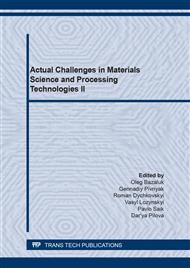[1]
Nallusamy, S., & Majumdar, G. (2016). Effect of Stacking Sequence and Hybridization on Mechanical Properties of Jute-Glass Fiber Composites. International Journal of Performability Engineering, 12(3), 229-239. https://doi.org/10.23940/IJPE.16.3.P229.MAG.
Google Scholar
[2]
Saw, S. K., Akhtar, K., Yadav, N., & Singh, A. K. (2014). Hybrid composites made from jute/coir fibers: Water absorption, thickness swelling, density, morphology, and mechanical properties. Journal of Natural Fibers, 11(1), 39-53.
DOI: 10.1080/15440478.2013.825067
Google Scholar
[3]
Abdellaoui, H., Bensalah, H., Echaabi, J., Bouhfid, R., & Qaiss, A. (2015). Fabrication, characterization and modelling of laminated composites based on woven jute fibres reinforced epoxy resin. Materials and Design, 68, 104-113. https://doi.org/10.1016/j.matdes.2014.11.059.
DOI: 10.1016/j.matdes.2014.11.059
Google Scholar
[4]
Aseer, J.R., Sankaranarayanasamy, K., Jayabalan, P., Natarajan, R., & Dasan, K.P. (2015). Mechanical and water absorption properties of municipal solid waste and banana fiber-reinforced urea formaldehyde composites. Environmental Progress and Sustainable Energy, 34(1), 211-221. https://doi.org/10.1002/ep.11966.
DOI: 10.1002/ep.11966
Google Scholar
[5]
Petrucci, R., Santulli, C., Puglia, D., Sarasini, F., Torre, L., & Kenny, J.M. (2013). Mechanical characterisation of hybrid composite laminates based on basalt fibres in combination with flax, hemp and glass fibres manufactured by vacuum infusion. Materials and Design, 49, 728-735. https://doi.org/10.1016/j.matdes.2013.02.014.
DOI: 10.1016/j.matdes.2013.02.014
Google Scholar
[6]
Ramesh, M., Palanikumar, K., & Reddy, K.H. (2013). Mechanical property evaluation of sisal-jute-glass fiber reinforced polyester composites. Composites Part B: Engineering, 48, 1-9. https://doi.org/10.1016/j.compositesb.2012.12.004.
DOI: 10.1016/j.compositesb.2012.12.004
Google Scholar
[7]
Jawaid, M., Alothman, O. Y., Paridah, M.T., Khalil, A., & Arabia, S. (2014). Effect of Oil Palm and Jute Fiber Treatment on Mechanical Performance of Epoxy Hybrid Composites. International Journal of Polymer Analysis and Characterization, 19(1), 62-69. https://doi.org/10.1080/1023666X.2014.858429.
DOI: 10.1080/1023666x.2014.858429
Google Scholar
[8]
Ramnath, B.V., Elanchezhian, C., Nirmal, P.V, Kumar, G.P., & Kumar, V.S. (2014). Experimental Investigation of Mechanical behavior of Jute-Flax Based Glass Fiber Reinforced Composite. Fibers and Polymers, 15(6), 1251-1262. https://doi.org/10.1007/s12221-014-1251-3.
DOI: 10.1007/s12221-014-1251-3
Google Scholar
[9]
Hanan, F., Jawaid, M., Tahir, P., Hanan, F., & Jawaid, M. (2020). Mechanical performance of oil palm / kenaf fiber- reinforced epoxy-based bilayer hybrid composites epoxy-based bilayer hybrid composites. Journal of Natural Fibers, 17(2), 155-167. https://doi.org/10.1080/15440478.2018.1477083.
DOI: 10.1080/15440478.2018.1477083
Google Scholar
[10]
Dalbehera, S., & Acharya, S.K. (2015). Effect of cenosphere addition on the mechanical properties of jute-glass fiber hybrid epoxy composites. Journal of Industrial Textiles, (1), 1-12. https://doi.org/10.1177/1528083715577936.
DOI: 10.1177/1528083715577936
Google Scholar
[11]
Ahmed K.S, Vijayarangan S,K.A. (2007). Low Velocity Impact Damage Characterization of Woven Jute - Glass Fabric Reinforced Isothalic Polyester Hybrid Composites. Composites. Journal of Reinforced Plastics and Composites, 26(10), 959-976. https://doi.org/10.1177/0731684407079414.
DOI: 10.1177/0731684407079414
Google Scholar
[12]
De Rosa, I. M., Santulli, C., Sarasini, F., & Valente, M. (2009). Post-impact damage characterization of hybrid configurations of jute/glass polyester laminates using acoustic emission and IR thermography. Composites Science and Technology, 69(7-8), 1142-1150. https://doi.org/10.1016/j.compscitech.2009.02.011.
DOI: 10.1016/j.compscitech.2009.02.011
Google Scholar
[13]
Nisini, E., Santulli, C., & Liverani, A. (2017). Mechanical and impact characterization of hybrid composite laminates with carbon, basalt and flax fibres. Composites Part B: Engineering, 127, 92-99. https://doi.org/10.1016/j.compositesb.2016.06.071.
DOI: 10.1016/j.compositesb.2016.06.071
Google Scholar
[14]
Gujjala, R., & Ojha, S. (2014). Mechanical properties of woven jute-glass hybrid-reinforced epoxy composite. Journal of Composite Materials, 48(28), 3445-34. https://doi.org/10.1177/0021998313501924.
DOI: 10.1177/0021998313501924
Google Scholar
[15]
Ahmed, K.S., & Vijayarangan, S. (2008). Tensile, flexural and interlaminar shear properties of woven jute and jute-glass fabric reinforced polyester composites. Journal of Materials Processing Technology, 207, 330-335. https://doi.org/10.1016/j.jmatprotec.2008.06.038.
DOI: 10.1016/j.jmatprotec.2008.06.038
Google Scholar
[16]
John, K.N.S. (2004). Sisal Fiber / Glass Fiber Hybrid Composites: The Impact and Compressive Properties. Journal of Reinforced Plastics and Composites, 23(12), 1253-1258. https://doi.org/10.1177/0731684404035270.
DOI: 10.1177/0731684404035270
Google Scholar
[17]
Assarar, M., Zouari, W., Sabhi, H., Ayad, R., & Berthelot, J. (2015). Evaluation of the damping of hybrid carbon – flax reinforced composites. Composite Structure, 132, 148-154. https://doi.org/10.1016/j.compstruct.2015.05.016.
DOI: 10.1016/j.compstruct.2015.05.016
Google Scholar
[18]
Aziz, S.H., & Ansell, M.P. (2004). The effect of alkalization and fibre alignment on the mechanical and thermal properties of kenaf and hemp bast fibre composites: Part 1 - polyester resin matrix. Composites Science and Technology, 64(9), 1231-1238. https://doi.org/10.1016/j.compscitech.2003.10.001.
DOI: 10.1016/j.compscitech.2003.10.001
Google Scholar


